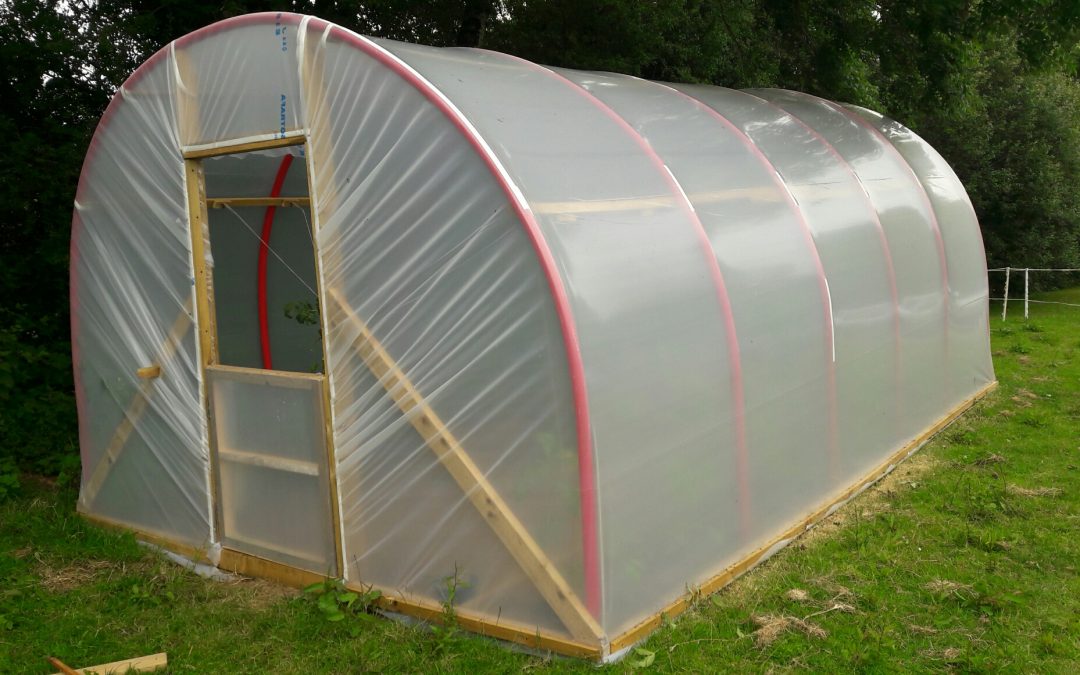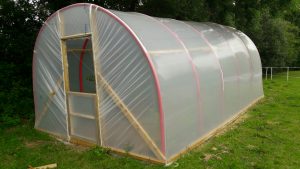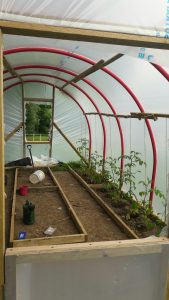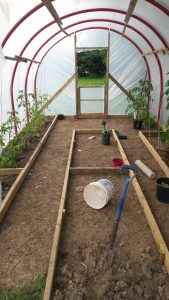
Update on our polytunnel – we’re growing!
We were delighted to finally finish our poly-tunnel in early June, just in time to transplant a batch of 20 tomato plants from pots into their new home, before they started wilting in their pots.
The plastic (polythene) cover proved to be quite easy to attach to the frame to complete the structure. (OMG! – did we just blow our whole year’s household efforts to avoid plastic – out of the water!! – we did think about this…)
The secret is to stretch it across the length of the tunnel first (from door to door) and then stretch it from side to side moving from one side to the same position on the other side to pull it taut in between. We used 2×1 sections screwed into the base boards to fix the polyethene in place. One person pulling to apply tension and the other person fixing. This process worked well with two of us helping, and we had the cover fitted in a half a day. Note also that it’s best done on a sunny day with no wind. The sun will warm the plastic and make it easier to stretch fully. This ensures it stays tight during hot weather times. The heat tape applied to the supports did make it easier to pull and stretch the plastic without risking any damage where it came into contact with rough timber. So although it may not be necessary to prevent burning of the plastic during its lifetime as it’s not in contact with any material that will heat-up, it did seem worthwhile just as a smooth contact surface in certain locations.
 We opted to go with a half door at the front (lower half can be seen in the picture shown) so the top half can be left open for ventilation, while the other end has a large, (as yet open) vent. We figured that as much ventilation as possible is best for now until the weather turns bad again, so we haven’t finished those openings off yet.
We opted to go with a half door at the front (lower half can be seen in the picture shown) so the top half can be left open for ventilation, while the other end has a large, (as yet open) vent. We figured that as much ventilation as possible is best for now until the weather turns bad again, so we haven’t finished those openings off yet.
All in all, it was quite manageable and we are happy with our cost estimate of about half the price to build it as to buy a kit, although that doesn’t account for the time cost in putting it together which was significant.
Once the shell was finished, we used remaining 2×4” lengths to lay out the beds inside. We opted for 2 foot wide beds at the sides where access was restricted to one side, while a 3-foot wide centre bed left two sufficiently wide 2 foot paths running the length of the space. A little extra room was also left around the door for an eventual work surface or just room to “potter”. We had hoped to also include space for the kids as this may turn into a nice winter-time sheltered play area for them to get out of the house. That’s another day’s work though.
We have yet to figure out a good water supply and are opting to run a long hose from our house supply over to it for now. Eventually, we plan to collect the rainwater from the tunnel itself to use inside for plant watering. It seems this can be done easily using a stuck-on strip of plastic to guide the water off the wall a nd in
nd in to a butt. We plan to look into this further.
to a butt. We plan to look into this further.
An interesting side note at this point is that our tunnel happens to be right beside where our deep water well (200ft) is located. So in effect, we are pumping water out of the ground, sending it into the house, through it, back out again and over to our polytunnel next to the water source. In the spirit of self-sufficiency which we are all about, we did some investigation into manual well-pumps.
We have semi-regularly been caught out without power for hours at a time. While it’s never been anything more than a few hours, still it can be quite an inconvenience if it goes beyond this, with water supply being the first problem we would encounter as we use a pressurised system.
Being self-reliant for our water supply, it’s nice to know where our water comes from and to know its quality to some degree, but we are entirely dependent on our electricity supply to access the water we need. So, what about a major disruption of power in the event of a serious storm?
It seems that photo-voltaic powered pumps are not powerful enough to lift water from such a depth, but there are manual pumps which can do this. Interestingly the major suppliers of these seem to be US based as there is quite a market there for off-grid survival enthusiast equipment. There just don’t seem to be the same options available closer to home. Perhaps we are too trusting of our service providers over here?
One example is the Bison Deep well pump which is a very expensive option but appears to be very well made and capable for such deep wells. ANother example is shown here. These pumps are about $1500 to $2000, but are well engineered and made to last. We haven’t done anything about this yet, but the idea of being able to hand- pump water for our polytunnel and for our home in the case of emergency is appealing. We don’t want to go too “survivalist” on you, but one just never knows. We all tend to be too accustomed to our comforts to really give any thought as to how we could manage in emergency situations, which can and do happen in various parts of the world.
Shortly after we finished and were admiring our work, someone accidentally had a run in with the side of the tunnel leaving a large gash in the polythene. This was, of course, always going to happen at some point, but within days of completing it! anyway, make sure to get some of the polythene repair tape sold by polytunnel suppliers for repairing the holes. It seems to work reasonably well.
Now, all we need is the sun to get our tomato crop blooming.

